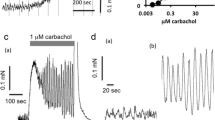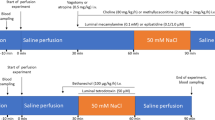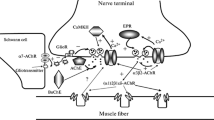Abstract
The effect of aclatonium napadisilate, a choline sulfonate derivative, on exocrine and endocrine pancreatic functions was compared with that of carbamylcholine in both isolated pancreatic acini and the isolated perfused pancreas of rats. In the isolated acini, aclatonium napadisilate and carbamylcholine stimulated amylase release. While the relative efficacy of aclatonium napadisilate was the same as that of carbamylcholine, aclatonium napadisilate was about 20-fold less potent. In the isolated perfused pancreas, 0.1 ΜM or higher concentrations of aclatonium napadisilate elicited a significant insulin release in the presence of 8.3 mM glucose, whereas an appreciable increase in pancreatic exocrine secretion was obtained with a 10 times higher concentration (1.0 ΜM). In contrast, carbamylcholine did not stimulate insulin release at a dose (0.1 ΜM) that stimulated pancreatic exocrine secretion. The insulin-releasing effect of aclatonium napadisilate depended on the glucose concentration. These stimulatory effects of aclatonium napadisilate on endocrine and exocrine pancreatic secretion were inhibited by the muscarinic receptor antagonist pirenzepine but were not affected by the cholecystokinin receptor antagonist proglumide. These results indicate that aclatonium napadisilate stimulates both endocrine and exocrine pancreatic secretion via muscarinic receptors and that its action on B cells is more potent than on the exocrine pancreas.
Similar content being viewed by others
References
Williams JA: Anin vitro evaluation of possible cholinergic and adrenergic receptors affecting pancreatic amylase secretion. Proc Soc Exp Biol Med 150:513–516, 1975
Gardner JD, Jackson ML: Regulation of amylase release from dispersed pancreatic acinar cells. J Physiol (London) 270:439–454, 1977
Otsuki M, Nakamura T, Okabayashi Y, Oka T, Fujii M, Baba S: Comparative inhibitory effects of pirenzepine and atropine on cholinergic stimulation of exocrine and endocrine rat pancreas. Gastroenterology 89:408–414, 1985
Collen, MJ, Sutliff VE, Pan G-Z, Gardner JD: Postreceptor modulation of action of VIP and secretin on pancreatic enzyme secretion by secretagogues that mobilize cellular calcium. Am J Physiol 242:G423-G428, 1982
Beglinger C, Grossman MI, Solomon TE: Interaction between stimulants of exocrine pancreatic secretion in dogs. Am J Physiol 246:G173-G179, 1984
Singer MV, Solomon TE, Wood J, Grossman MI: Latency of pancreatic enzyme response to intraduodenal stimulants. Am J Physiol 238:G23-G29, 1980
Miller RE: Pancreatic neuroendocrinology: peripheral neural mechanisms in the regulation of the islets of Langerhans. Endocrine Rev 2:471–94, 1981
Grill V, Ostenson C-G: Muscarinic receptors in pancreatic islet of the rat. Demonstration and dependence on long-term glucose environment. Biochim Biophys Acta 756:159–162, 1983
Miura K, Takeda R, Nakamoto H, Saito H: The chemical and pharmacological study of Puerariae radix (Pueraria hirsuta Matsumura). Oyo Yakuri 5:247–254, 1971
Miura K, Suzuki Y, Masumoto Y, Imamura M, Kongo K, Muroda H, Asai N, Nishida N, Kodama T: The pharmacological study of acetyllactoylcholine 1,5-naphthalenedisulfonate (TM723). Part 1. Main effects of TM 723 on the digestive system. Oyo Yakuri 13:497–507, 1977
Takagi K, Imamura M: The effect of acetyllactoylcholine-1,5-naphthalenedisufonate (TM723) on the gastrointestinal tract. Oyo Yakuri 13:509–512, 1977
Takagi K, Imamura M, Okabe S: The effect of acetyllactoyl-choline-1,5-naphthalenedisulfonate (TM723) and methyl-N-trimethyl-r-aminobutylate chloride (Actinamine) on gastric secretion and motility in rats and dogs on the gastrointestinal tract. Oyo Yakuri 13:513–518, 1977
Williams JA, Korc M, Dormer RL: Action of secretagogues on a new preparation of functionally intact, isolated pancreatic acini. Am J Physiol 235:E517-E524, 1978
Otsuki M, Williams JA: Effect of diabetes mellitus on the regulation of enzyme secretion by isolated rat pancreatic acini. J Clin Invest 70:148–156, 1982
Otsuki M, Sakamoto C, Yuu H, Maeda M, Morita S, Ohki A, Kobayashi N, Terashi K, Okano K, Baba S: Discrepancies between the doses of cholecystokinin or caerulein stimulating exocrine and endocrine responses in perfused isolated rat pancreas. J Clin Invest 63:478–484, 1979
Gardner JD, Jensen RT: Cholecystokinin receptor antagonists. Am J Physiol 246:G471-G476, 1984
Ceska M, Birath K, Brown B: A new and rapid method for the clinical determination of α-amylase activities in human serum and urine. Clin Chim Acta 26:437–444, 1969
Lowry OH, Rosebrough NJ, Farr AL, Randall RJ: Protein measurement with Folin phenol reagent. J Biol Chem 193:265–275, 1951
Desbuquios B, Aurbach GD: Use of polyethyleneglycoal to separate free and antibody-bound peptide hormones in radio-immunoassay. J Clin Endocrinol Metab 33:732–738, 1971
Hammer R, Berrie CP, Birdsall WJM, Burgen ASV, Hulme EC: Pirenzepine distinguishes between different subclasses of muscarinic receptors. Nature 283:90–92, 1980
Watson M, Yamamura HI, Roeske WR: A unique regulatory profile and regional distribution of [3H]pirenzepine in the rat provide evidence for distinct M1 and M2 muscarinic receptor subtypes. Life Sci 32:3001–3011, 1983
Louie DS, Owyang C: Muscarinic receptor subtypes on rat pancreatic acini: Secretion and binding studies. Am J Physiol 251:G275-G279, 1986
Kimura H, Katagiri K, Ohno T, Harada, N, Imanishi H, Iwasaki M, Takeuchi T: Effect of acetylcholine and new cholinergic derivative on amylase output, insulin, glucagon, and somatostatin secretions from isolated rat pancreas. Horm Metab Res 14:356–360, 1982
Nakashima Y, Ikegami T, Hayahawa H, Takagawa N, Yamauchi H, Takagi T, Takeshima K, Hamatani Y, Takai A: Studies on the absorption, excretion, distribution and metabolism of (2-acetyllactoyloxyethyl)trimethylammonium 1,5-naphthalene-disulfonate (TM-723). Oyo Yakuri 18:723–748, 1979
Author information
Authors and Affiliations
Additional information
This work was supported in part by a grant from the Japanese Ministry of Health and Welfare (Intractable Diseases of the Pancreas).
Rights and permissions
About this article
Cite this article
Otsuki, M., Nakamura, T., Okabayashi, Y. et al. Effect of a new cholinergic agonist, aclatonium napadisilate, on exocrine and endocrine rat pancreas. Digest Dis Sci 34, 1249–1256 (1989). https://doi.org/10.1007/BF01537274
Received:
Accepted:
Issue Date:
DOI: https://doi.org/10.1007/BF01537274




